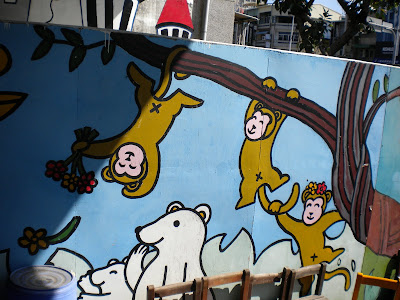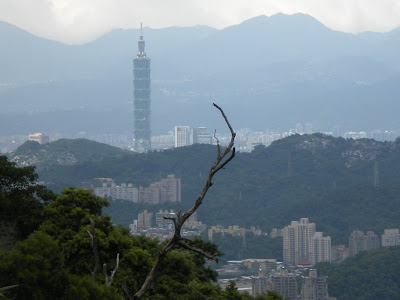

Well, its been an interesting few days. Friday, I decided to pick a really distant and remote place from the guidebook and visit it. I picked Beipu, a small, formerly frontier, Hakka town, in eastern Hsinchu county, at the foot of the hills. The trip took a few hours and several buses to get there and two buses, and train, and almost 2 hours to return. Along the way, I studied Chinese, finished reading a book by former Yale professor Gus Speth, and started reading another former Yale professor and one of the worlds greatest historians, Jonathon Spence. Jonathon Spence's book,
The Death of Woman Wang, portrays life in rural northern China during the 17th century, in a time and place overlooked by major histories. It follows the lives of several real life personalities in the small town through their trials and tribulations. All of this is based on historical records and offers a glimpse of a wild and forgotten time. Thanks Dad for getting me the book.
Beipu is a facinating town. The early 19th century houses, brick lanes, and dusty, store-lined streets could have fit in during the same time period in the American West. The beautiful old town temple, along with the well-preserved houses of the town's 19th century elite are must-see attractions. Tasting the food is another must. Hakka flat noodles (Bantiao), Hakka pounded tea (Leicha), and Hakka glutinous cakes (Mashu) are all superb. As it was a weekday and tourists were not as plentiful, the owners of a local tea shop were able to chat with me for some time. The whole family was very friendly and even offered to show me around town. I will definitely return to Beipu and bring friends to their teashop.
What a really loved about Beipu was that the old houses, instead of being torn down, were actually renovated, brining in tourism, preserving history, and preventing displacement of the local community, so deferent from the dramatic, violent, and sometimes poorly planned gentrification in New York City. Instead of tearing down history and displacing communities, the leaders in Beipu, transformed the town into a trade and tourism center, bringing in capital and resources for community-based development.
So, who are the Hakka and how did they end up in Beipu? Several hundred years ago, people from northern China began to migrate south in search of land. When they arrived in Guangdong, Fujian, and Guangxi they found people there, lots of people. For survival, they settled in the hills, farming and trading and speaking a unique dialect. While very much Han Chinese, their linguistic differences made them essential a minority surrounded by hostile Cantonese. Their women did not bind their feet and were thus able to work the land, while the men traveled the provinces as doctors, merchants, and businessmen. Parallels can be seen with the Jews of Eastern Europe, who, migrating east in search of opportunity and freedom from the antisemitism of medieval Central and Western Europe, found themselves in the breadbasket of the Russian Empire, setting up unique communities and because of a lack of access to land, often working in trade. Much as the language of Ashkenazi Jews, Yiddish, is today struggling for survival, the Hakka in China and Taiwan have struggled against language death for decades. Much as the Jews were both a valuable scapegoat for the Russian Empire's rulers and often leaders of revolutionary threats, so were the Hakka in imperial China. The leader of the Christian Taiping Rebels who challenge the Manchu and foreign powers in what would be the second bloodiest war in human history and the largest peasant rebellion was Hong Xiuquan, a Hakka. Many rumor Sun Yat-sen and Mao Zedong were also Hakka. Deng Xiaoping, while also rumored to be part Hmong, was also certainly Hakka. During revolutions and wars, Hakka families served as important couriers and leaders in a linguistically and racially fragmented southern China.
During the 18th and 19th century, thousands of Hakka fled to Taiwan to escape the often violent discrimination they faced in Southern China. They settled in the coastal cities of Taiwan, but finding job competition fierce amongst the Minan-speaking Taiwanese, they migrated to the foot of the hills, a frontier people sandwiched between Minan Taiwan and aboriginal Taiwan.
The next day I had my first trip with ICLP. I met many students, including some from New York, Colorado, California, Germany, Australia, England, and Thailand. Along with the two teachers who accompanied us, we took the metro to Maokong and then took a bus to the tea house where we tried delicious tea, learned the so-called "tea making ceremony", and tried a few snacks. It was raining heavily, but the rain seemed to lighten up when we were not in the tea house or on a bus.
Monday we had introductory lectures on which eateries in the area offer which delicious foods and on the proper etiquette to use in Taiwan. One teacher described Taiwan as "not as coarse as China but not as overly polite as Japan." Tuesday, we had our orientation and a campus tour. I had breakfast with a student from California and lunch with several other students. During the orientation, we received a student guidebook as well as another guidebook on food.
We received some advice from alumni on the program. The advice was helpful, but sometimes contradictory, including both warnings not to overwork and miss out on life in Taipei and not to study too little and fall behind. I will try to strike a balance between in-class and out-0f-the-classroom learning. Of course, what's best is when you are able to take what you've learned in class and use it on the street.
Today was mid-Autumn festival, which for me meant that I would neither have class today nor be able to use the pool. I studied Chinese, wrote in my journal, blogged, shopped, and did chores. My neighbor Mr. Qiu took me to a local eatery with decent food where we tried some of the dishes and then went to his local temple. The temple featured beautiful statues of Guan Yin, Guan Gong, and other Buddhist and Taoist dieties. We lit incense, and predicted our fortunes. My slip said something I did not completely understand, but I think it was telling me to live life to the fullest.
After the temple, we went to look at houses in Da-an and Zhong-zheng districts which were built in the Japanese era. Many were crumbling, some had been destroyed to build luxury housing, and some had been protected, renovated, and turned into quite nice living spaces. We also passed the first area since I visited the reservation near Sun Moon Lake that had that depressed look about it that all places going through economic hardship do. The area was a stone's through from the Chiang Kai-Shek memorial, the irony of which is enough to make one's blood boil. These areas are the homes of the refugees and former soldiers who followed Chiang Kai-Shek to Taiwan, as well as their descendants. While the professionals and wealthy individuals who came with the dictator to Taiwan prospered, the impoverished soldiers who followed them ended up stranded in slums, lacking skills, hated by the local population, and forgotten by a dictator whose mind was only on reconquest. The old dilapidated houses and proudly hung Chinese Republic flags remind me of trailer parks and other areas in America where some of America's poorest and most forgotten remain some of America's most patriotic. I had spent some time last summer with groups which among other things were fighting gentrification in Manhattan Chinatown and I had a lively discussion with Mr. Qiu. I explained how America's poor were being forced by the millions from their communities to build luxury housing for America's elites and how this trend was targeting communities of color, including working class Chinese American neighborhoods. He seemed to feel that while a lot of history is lost and many are displaced by gentrification, in general it can be seen as a good trend. "The world's population is going up, without building new homes, where will people live?" Still, I asked him if he thought the luxury buildings being built next to the old army refugee camps would be made affordable to the displaced old veterans. He doubted it. I asked him if he thought he could afford an apartment in one of the luxury, well-guarded homes going up in Zhong-zheng, to which he responded "definitely not". In the end we both agreed the issue was complicated and difficult to understand.
Upon returning to my house, I ran into Sean and his girlfriend. She had just returned from several months studying and working in America. She had visited San Francisco, Chicago, Niagra Falls, and New York. She lived in Flushing for a while while working in New York, both at 6 Flags and at a Mexican restaurant in New York. Both of her bosses had withheld some of her wages and one had not paid minimum wage. I told her about Chinese Staff and Workers Association (one of the groups in New York I had worked with) and we had an interesting discussion about life in America and American culture. Her English was nearly perfect and she spent some time to talking to Andrew and some of our other roommates.
Tomorrow we are introduced to our courses at ICLP and I will be taking the NTU Chinese proficiency exam.
Pictures:
Misty Mountain Maokong
Having tea with ICLP students
ICLP students and teachers getting off the bus and going to the teahouse.

Old House in Beipu
Pickup truck in Beipu
(I have an affinity for blue pickup trucks)
Teahouse in Beipu
Hakka Mashu
Hakka Leicha
Downtown Beipu
(I feel I could film a John Wayne film here
with cowboys and horses and all).
Main temple in Beipu.























































